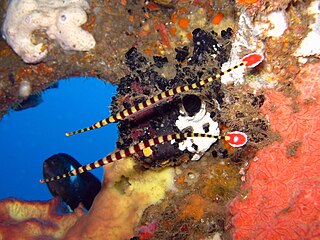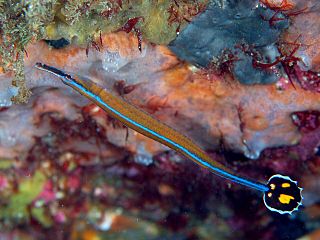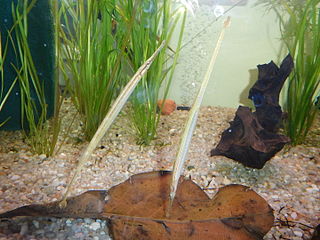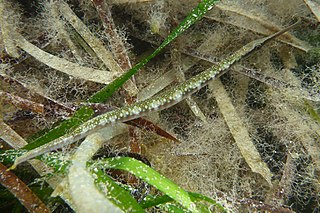Related Research Articles

The Syngnathidae is a family of fish which includes seahorses, pipefishes, and seadragons. The name is derived from Ancient Greek: σύν, meaning "together", and γνάθος, meaning "jaw". The fused jaw is one of the traits that the entire family have in common.

Pipefishes or pipe-fishes (Syngnathinae) are a subfamily of small fishes, which, together with the seahorses and seadragons, form the family Syngnathidae.

Syngnathus is a genus of fish in the family Syngnathidae found in marine, brackish and sometimes fresh waters of the Atlantic, Indian and Pacific Ocean. Fossils of these species are found from the Oligocene to the Pleistocene. They are known from various localities of Greece, Italy, Germany and United States.
Leptonotus is a genus of pipefishes of the family Syngnathidae. The name is derived from the Greek leptos meaning "thin" and noton meaning "back".

The banded pipefish or ringed pipefish is a species of fish in the Syngnathidae family.

Doryrhamphus and Dunckerocampus, popularly known as flagtail pipefish, are two genera of fishes in the family Syngnathidae. They are found in warm, relatively shallow waters of the Indo-Pacific, with a single species, D. paulus, in the eastern Pacific. Most of these pipefishes are very colourful, and are fairly popular in the marine aquarium hobby despite requiring special care and not being recommended for beginners.

Microphis is a genus of pipefishes within the family Syngnathidae. Members of this genus are notable among the Syngnathidae for residing in mainly fresh and brackish waters. Adults breed in coastal rivers, streams, or lakes, and fertilized eggs are carried by the male pipefish in a brood pouch extending along his entire ventral surface.

Schultz's pipefish, Corythoichthys schultzi, is a pipefish of the family Syngnathidae.

Centropyge heraldi, the yellow angelfish or Herald's angelfish is a species of marine ray-finned fish, a marine angelfish belonging to the family Pomacanthidae. It comes from the Pacific Ocean and sometimes makes its way into the aquarium trade.
Doryrhamphus janssi, commonly known as the Janss' pipefish , is a species of pipefish belonging to the family Syngnathidae.

Doryrhamphus is a genus of pipefishes, one of the two genera colloquially known as flagtail pipefishes and are popular in the aquarium trade. The members of this genus are native to the Indian and Pacific Oceans where they inhabit reef environments. The species in this genus have a maximum length of 14 centimetres (5.5 in) or less, with D. janssi being the only species that surpasses 8.5 centimetres (3.3 in). Most species have a horizontal blue line along their body, and all have a whitish-edged tail that is marked contrastingly with black, red or yellow.
The Yucatán pipefish is a demersal fish species native to the Gulf of Mexico.

Syngnathus dawsoni is a species of the pipefishes. It occurs in the central, western Atlantic in the Caribbean Sea from Puerto Rico to St. Lucia and has been recorded only from the east of the Mona Passage. It is a marine tropical demersal fish. It is ovoviviparous; the male carries the fertilized eggs in a brood pouch located under his tail. It has been captured at around 7 metres (23 ft) in shallow, inshore water but its habits and ecology are unknown. The specific name honours Charles Eric Dawson who collected the type material and who recognised this species as different from the other Atlantic members of the family Syngnathidae.

Leptoichthys fistularius, the brush-tailed pipefish, is a species of pipefish of the family Syngnathidae, found in shallow to intermediate depths off the coast of southern Australia, usually in seagrass beds. This species is the largest known species of pipefish, growing to a maximum of 63 cm (25 in) in length. Like other pipefishes, the male carries the fertilized eggs in a pouch under his tail until they hatch. The genus name comes from the Greek leptos meaning "thin" and ichthys meaning "fish", the specific name refers to the resemblance of the head of this species to that of the fluteheads or cornetfishes of the family Fistulariidae.
Bryx is a genus of pipefishes.
The upside-down pipefish is a species of pipefish endemic to the coast of southern Australia, from New South Wales to Geographe Bay in Western Australia, where it is found in rocky reefs at depths of from 2 to 15 metres. It grows to a length of 9.2 centimetres (3.6 in) SL. This species is the only known member of its genus. Like other pipefish it is ovoviviparous but it may breed seasonally, as gravid males have been collected between September and November.
Paul Georg Egmont Duncker was a German ichthyologist.
Cosmocampus heraldi is a species of marine fish of the family Syngnathidae. It is known from only seven specimens, which were found at the Desventuradas and Juan Fernandez Islands in Chile. It inhabits rocky reefs and sandy areas at depths of 6–23 metres (20–75 ft), where it can grow to lengths of 7 centimetres (2.8 in). It is expected to feed on small crustaceans like other pipefish. This species is ovoviviparous, with males carrying eggs until giving birth to live young.
Maroubra perserrata, also known as the sawtooth pipefish is a species of marine fish belonging to the family Syngnathidae. This species can be found at depths up to 20 meters along the coast of Australia from southern Queensland to southern Western Australia. While they can live in many different habitats, they are often found inhabiting openings in reefs and rocks that contain algae and invertebrates, which they likely rely on for camouflage. Reproduction occurs through ovoviviparity in which the males brood eggs for roughly 22 days before giving live birth. Maroubra perserrata is considered more mobile than many pipefish species due to its prehensile tail and reduced caudal fin.
Minyichthys inusitatus, also known as the West Atlantic pipefish is a species of marine fish belonging to the family Syngnathidae. They have been be found off the coast of Panama and Northern Argentina, though little is known about their full geographic range or preferred habitat in these areas. Minyichthys inusitatus is thought to live primarily at depths of greater than 30–40 meters. Their diet likely consists of small crustaceans such as copepods, amphipods, and mysid shrimps. Reproduction occurs through ovoviviparity in which the males brood eggs before giving live birth. This small species grows only to lengths of around 2.9 cm on average.
References
- 1 2 3 4 5 6 7 George S. Myers; W.I. Follett; William A. Gosline (1974). "Earl Stannard Herald". Copeia. 1974 (1): 291–292. JSTOR 1443054.
- 1 2 "Science in Action (television show) Archive". California Academy of Sciences. Archived from the original on 2012-01-09. Retrieved 28 May 2018.
- ↑ J.R. Paxton (1975). "Heraldia nocturna, a new genus and species of pipefish (family Syngnathidae) from eastern Australia with comments on Maroubra perserrata Whitley". Proceedings of the California Academy of Sciences . 40: 439–447.
- ↑ R.A. Fritzsche (1980). "Revision of the eastern Pacific Syngnathidae (Pisces: Syngnathiformes), including both recent and fossil forms". Proceedings of the California Academy of Sciences. Series 4. 42 (6): 181–227. Retrieved 27 May 2018.
- ↑ Christopher Scharpf & Kenneth J. Lazara (21 July 2020). "Order ACANTHURIFORMES (part 1): Families LOBOTIDAE, POMACANTHIDAE, DREPANEIDAE and CHAETODONTIDAE". The ETYFish Project Fish Name Etymology Database. Christopher Scharpf and Kenneth J. Lazara. Retrieved 25 January 2021.
- ↑ "Aquarium's Dr. Herald Is Drowned", Oakland (CA) Tribune, January 18, 1973, p. 4 ("Dr. Earl Herald, 58... drowned while skin diving off Baja California Tuesday... He apparently suffered a heart attack while swimming alone off Cabo San Lucas.")
- ↑ "au:Herald, Earl Stannard". OCLC WorldCat. Retrieved 28 May 2018.
- ↑ Living Fishes of the World Hardcover – 1 Oct 1975 by Earl S. Herald (author). ASIN 0385009887.